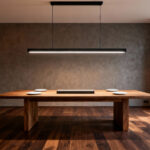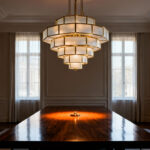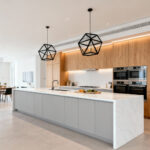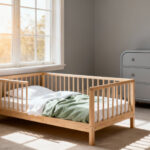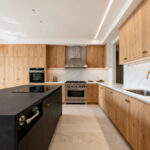Of all the design trends I’ve seen come and go over the last decade, the move toward green kitchens is the one that feels the most…human. For so long, we were told that kitchens had to be sterile, all-white spaces or safe, predictable gray. But I’ve noticed a shift. We’re craving homes that do more than just function; we want spaces that nurture us, that ground us, and that feel alive. And that’s exactly what green does. It’s a color that connects us back to the natural world.
What I love most is that choosing green isn’t just about painting cabinets. It’s about a deeper design philosophy—creating a heart of the home that’s restorative, calm, and ready for whatever life throws your way. It’s the perfect backdrop for a home that needs to work for everyone, from a toddler learning to help bake to a grandparent who values ease and clarity. Accessible design, after all, is just good design that anticipates our needs.
So, let’s walk through how you can bring this incredible color into your own space. Forget rigid rules and think of this as a conversation—a set of ideas to help you create a kitchen that is both stunningly beautiful and deeply practical for years to come.
1. Find Your Sanctuary with Calming Green Tones
There’s a reason we feel better after a walk in the woods. Our brains are wired to respond to the colors of nature. Bringing those hues inside isn’t just a style choice; it’s a form of self-care. A soft sage green, a muted olive, or even a pale, watery celadon can transform a kitchen from a high-stress “production zone” into a place where you can actually take a deep breath.

I once worked with a family whose teenage son had sensory sensitivities. His mom told me their stark white kitchen felt “loud” to him. We repainted the cabinets in a deep, matte moss green, and the change was immediate. The room felt quieter, calmer. The simple act of making breakfast became less of a frantic rush and more of a gentle start to the day. That’s the power of color. It’s not just decoration; it’s about creating an environment that supports your well-being.
As we think about designing for the long haul, creating this kind of peace becomes even more important. A serene kitchen is a gift to your future self.
2. Choose the Right Green for Your Space
Now, here’s where people often get stuck: which green is the right green? There are literally thousands of them. The secret isn’t finding a “perfect” color in the store, but finding the one that comes alive in your home. The biggest mistake I see is people choosing a color under fluorescent hardware store lights and being shocked when it looks completely different in their kitchen.

You have to live with a sample for a few days. Tape a large painted swatch to a cabinet and watch what it does. How does it look in the morning sun? On a gray, rainy afternoon? Under your artificial lights at night? A warm olive that looks gorgeous in a sunny, south-facing kitchen might look a bit drab in a darker, north-facing room, which might do better with a brighter sage that has a touch of yellow in it. Trust your eyes and your space, not just the picture on a paint can.
Don’t get too hung up on technical terms like warm or cool undertones. Just ask yourself: does this color make me feel good when I’m in this room? That’s the only question that truly matters.
3. Pair Green Cabinets with a Perfect (and Practical) Countertop
Your countertop is the cabinet’s most important partner. Get this pairing right, and the whole kitchen sings. While there are tons of beautiful options, my universal design brain always prioritizes one thing first: contrast. For a kitchen to be truly usable for people of all ages and visual abilities, you need to be able to clearly see where the counter ends and the cabinets begin.

This is why white or light-colored quartz is such a classic choice with green cabinets. It provides a crisp, clean line that’s both visually stunning and incredibly practical for safety. A darker green cabinet with a light countertop is a home run for aging-in-place design. But it’s not the only option! I love the warmth of a butcher block or a light wood with a deep forest green—it just doubles down on that natural, organic feeling. The key is to avoid materials that are too similar in value (lightness or darkness) to your cabinet color, which can make the edges visually blur together.
It’s a small detail that makes a world of difference in a home you plan to live in for a long, long time.
4. Let Your Backsplash Tell a Story
Think of the backsplash as the bridge between your green cabinets and your countertop. This is where you can add personality and texture. A simple, classic white subway tile is a can’t-go-wrong choice; it provides a quiet backdrop that lets the green be the star. For a little more character, try stacking the tiles vertically or laying them in a herringbone pattern. It adds movement without adding noise.

But here’s where you can have some fun. I’m a huge fan of handmade Zellige tiles. Their subtle imperfections and variations in glaze catch the light beautifully and add a layer of warmth and history that mass-produced tile just can’t match. Paired with green cabinets, they create a look that feels both earthy and incredibly sophisticated. If you opt for a bold green, a simple slab of the same material as your countertop can create a seamless, calming effect.
Remember, the goal is harmony, not competition. Your backsplash should support your cabinets, not fight them for attention.
5. Choose Hardware that Shines
Hardware is the jewelry of your kitchen. It’s a small detail that has a massive impact on the finished look. With green cabinets, warm metals are almost always a winning combination. Brass, bronze, or champagne gold create a gorgeous contrast against nearly any shade of green, from sage to emerald. The warmth of the metal brings out the richness in the color and feels timeless.

From an accessibility standpoint, the shape of the hardware is just as important as the finish. Knobs can be tricky for people with arthritis or limited hand strength to grip. I always recommend pulls, specifically D-shaped or bar pulls. They are easy to grab with a whole hand or even just a few fingers, making them user-friendly for everyone. Matte black is another fantastic option, especially with lighter greens, as it provides that wonderful high contrast we talked about.
Whichever finish you choose, use it consistently for your cabinet pulls, faucet, and even your light fixtures to create a cohesive, intentional look.
6. Layer Your Lighting to Make the Color Pop
You can pick the most beautiful green on earth, but if your lighting is bad, the color will fall flat. A single overhead light creates harsh shadows and makes a space feel dreary. Great kitchen lighting is all about layers. This is non-negotiable for both beauty and safety.

Start with your task lighting. Under-cabinet LED strips are essential. They illuminate your countertops so you can see what you’re doing, and they also cast a lovely glow that highlights the color of your cabinets. Then, add your ambient light—usually recessed cans in the ceiling. Finally, bring in the accent lighting, like a beautiful pendant over the island or sink. Put everything on a dimmer. This is so important. It allows you to have bright, clear light when you’re cooking and a soft, warm glow for a quiet cup of tea in the evening.
When you’re choosing bulbs, look for a warm white light (around 2700K-3000K). It will make your green cabinets look rich and inviting, never sterile or cold.
7. Find Flooring that Grounds the Room
Your floor is the foundation of the entire design, and it needs to feel like a supportive base for your green cabinets. Natural hardwood floors are a classic partner. The warmth of light oak, maple, or hickory plays beautifully against almost any green, keeping the room feeling open and connected to nature.

One thing to keep in mind is the undertone. If you have a warm, olive-y green, stick with floors that have warm, golden, or reddish undertones. If you have a cooler, blue-toned green like eucalyptus or seafoam, a floor with grayer or more neutral undertones might work better. The goal is a subtle harmony. I’ve also seen stunning designs with large-format slate or terracotta tile, which can add a beautiful, earthy texture to the space.
This is a decision that impacts the entire feel of your home, so choose something that not only looks good but also feels good underfoot and will stand the test of time.
8. Use an Accent Wall to Add Depth
In an open-concept home, a strategic accent wall can be a great way to anchor the kitchen area and make your green cabinets really stand out. Think of it like a frame for your beautiful new kitchen. This doesn’t have to be a loud, bright color. In fact, sometimes the opposite is more effective.

For instance, behind a wall of light sage green cabinets, a deep charcoal or even a dark navy wall can create a dramatic, sophisticated backdrop. The contrast makes the green feel even more vibrant. Alternatively, if you’ve chosen a bold hunter green for your cabinets, a simple wall of warm off-white or even textured plaster can provide a resting place for the eye and keep the space from feeling too heavy.
An accent doesn’t always have to be paint. A wall of reclaimed brick or natural stone can add incredible texture and reinforce that connection to natural materials.
9. Master the Two-Tone Kitchen
If you love the idea of green but are nervous about committing to a full wall of it, a two-tone design is the perfect solution. It’s a fantastic way to introduce color in a balanced, intentional way. The most popular approach is to use green on the lower cabinets and a light neutral, like white or a soft cream, on the uppers. This grounds the space with color while keeping the upper portion of the room feeling light and airy.

Another beautiful option I’ve used in several multi-generational homes is to have all the perimeter cabinets in a neutral shade and then make the island a statement piece in a gorgeous green. This not only creates a focal point but can also improve wayfinding and define the kitchen’s work zone, which is a subtle but helpful universal design principle.
The trick is to use the same countertop material and hardware on both cabinet colors to tie everything together into one cohesive design.
10. Balance Solid Doors with Open Shelving
A whole kitchen of solid green cabinet doors, especially in a darker shade, can sometimes feel a bit heavy. Breaking it up with sections of open shelving is a great way to lighten the mood and add a personal touch. It’s also incredibly practical.

I love using open shelving for everyday items—the plates you eat from, the glasses you drink from. This is a core concept in accessible design: keeping frequently used things within easy reach and sight. No more digging through a high cabinet for your favorite mug. You can see it and grab it. For a client who was a wheelchair user, we replaced most of her upper cabinets with lower open shelves, making her kitchen vastly more functional for her.
Use a beautiful wood like white oak or walnut for the shelves to add warmth, or paint them the same color as the wall for a more seamless, integrated look.
11. Make a Small Kitchen Feel Bigger with Light Green
It’s a common misconception that you should only use white in a small kitchen. Honestly, the right light green can work magic in a compact space. Shades like pale mint, celadon, or a light, airy sage reflect light beautifully and can make a small kitchen feel more open and expansive, especially when paired with a light countertop and backsplash.

The visual trick here is that these soft greens often echo the colors of the outdoors seen through a window, creating a seamless connection that blurs the lines between inside and out. This makes the room feel less confined. In a small kitchen, I would generally advise against very dark or saturated greens, which can absorb light and make the walls feel like they’re closing in.
Stick with lighter tones, keep the design clean and uncluttered, and your small green kitchen will feel like a jewel box, not a closet.
12. Go Bold and Grand in a Larger Space
If you’re lucky enough to have a large kitchen, you have the perfect canvas to make a truly stunning statement. This is where you can embrace those deep, dramatic greens—emerald, forest, hunter green. These rich, saturated colors bring a sense of history and sophistication to a large room that might otherwise feel a bit empty or soulless.

In a big space, you can play with different elements to create visual interest. You could have a full wall of tall pantry cabinets in a deep green, paired with a large island in a contrasting material like a warm rift-sawn oak. The key in a large kitchen is to create defined zones and focal points to keep it from feeling monotonous. Green cabinets are the perfect tool for doing just that.
Don’t be afraid to go bold. A grand kitchen deserves a grand gesture, and a rich green is a choice that feels both brave and timeless.
13. Choose Materials that Are Healthy for You and the Planet
There’s a natural synergy between the color green and the idea of eco-conscious living. If you’re choosing a color inspired by nature, it only feels right to choose materials that respect it. When I talk with clients about cabinetry, I always encourage them to ask about the materials behind the paint.

Look for cabinets built with FSC-certified wood, which guarantees it comes from responsibly managed forests. Ask for formaldehyde-free plywood boxes and low-VOC or zero-VOC paint finishes. These choices have a huge impact on your home’s indoor air quality, which is vital for everyone’s health, especially children, the elderly, or anyone with respiratory issues. It’s one of those invisible aspects of universal design that makes a massive difference in your daily well-being.
Building a “green” kitchen can be about so much more than just the color. It can be a commitment to a healthier home.
14. Keep Your Cabinets Looking Beautiful for Years
Once you have your beautiful new green kitchen, you’ll want to keep it looking that way. The good news is that high-quality cabinet finishes are incredibly durable, but they do appreciate a little bit of care. The most important thing is to simply wipe them down regularly with a soft, damp microfiber cloth. That’s it.

For anything greasy or sticky, use a mild solution of a few drops of dish soap in warm water. The key is to avoid harsh, abrasive cleaners or scrubby sponges, which can dull or even scratch the finish over time. And wipe up spills as soon as they happen, especially acidic things like lemon juice or tomato sauce, which can damage the paint if left to sit.
A little bit of gentle, consistent care is all it takes to protect your investment and ensure your cabinets look as good in ten years as they do the day they’re installed.
15. Budget Wisely for a Successful Project
A kitchen renovation is a major investment, and it’s important to go in with your eyes open. The cabinets themselves are the biggest line item, but it’s the other costs that often surprise people. As a rule of thumb, you can expect professional installation to add about 20-35% to the cost of the cabinets themselves. And it’s almost always worth it.

Then you have to factor in hardware, potential changes to your plumbing or electrical, and a contingency fund—I always recommend 10-15% of the total budget—for those little surprises that inevitably pop up once you open up the walls. I know it can feel like a lot, but choosing quality materials and professional installation is the best way to protect your investment. These are the things that ensure your kitchen will function beautifully and safely for decades.
If the budget is tight, consider a phased approach. Maybe you start with just the green lower cabinets and a new countertop and save the uppers and backsplash for a year later.
16. Boost Your Home’s Value with a Memorable Kitchen
While I firmly believe you should design your home for you and not for a hypothetical future buyer, the reality is that a thoughtfully designed kitchen is one of the best investments you can make in your home. And a beautiful green kitchen? That’s memorable.

In a sea of generic white and gray kitchens, a well-executed green kitchen stands out. It shows personality, quality, and a confident design vision. Real estate agents I’ve spoken to say that these are the kitchens that people remember after a day of house hunting. They are the ones that generate buzz. Choosing a timeless shade of green—a classic sage, olive, or forest—ensures it will appeal to a wide range of people, not just a passing trend.
It’s a perfect example of how making a choice that brings you daily joy can also be a very smart financial decision.
17. Sidestep the Most Common Design Mistakes
I’ve already touched on a few of these, but they bear repeating because they are so important. The number one mistake is not testing the color in your own home’s light. What looked like a perfect sage in the showroom can turn into a sad, minty mess under your kitchen’s specific lighting. Always, always test large samples.

The second big pitfall is a lack of contrast, particularly between the cabinets and the countertops. This is not just an aesthetic issue; it’s a real-world usability problem for anyone with less-than-perfect vision. You need that clear definition to navigate the space safely and confidently.
Finally, don’t forget the scale. A dark, moody forest green that looks incredible in a grand, high-ceilinged kitchen can feel overwhelming and cave-like in a small, galley-style space. Let the size and natural light of your room be your guide.
18. Accessorize with Natural, Complementary Decor
Once the cabinets are in, the real fun begins. Accessorizing your green kitchen is all about layering in textures and personal items that bring the space to life. Because green is a color from nature, it pairs beautifully with other natural materials.

Lean into it. Display your well-loved wooden cutting boards. Keep cooking utensils in a simple ceramic crock. Fill a beautiful wooden or stone bowl with fruit on the counter. And plants! You can’t have too many plants in a green kitchen. A pot of herbs on the windowsill not only looks and smells wonderful but is also practical. A trailing pothos on top of the cabinets adds a touch of lushness.
These little touches are what transform a well-designed kitchen into a warm, inviting home. It’s about creating a space that feels collected and loved, not staged for a photoshoot.
19. Layer in Texture for an Organic, Lived-In Feel
Beyond just accessories, think about incorporating texture in the more permanent elements of your kitchen. A smooth, painted green cabinet door next to a rough, textural element creates a beautiful design tension that is incredibly appealing.

This could mean a backsplash of handmade tile with its subtle ripples and variations. It could be barstools with woven rush seats, or a light fixture made of natural rattan. Maybe it’s as simple as choosing linen tea towels over plain cotton. These textural elements engage more than just our sense of sight; they invite touch and make the space feel more grounded and comfortable.
A home that engages multiple senses is always more interesting and more restorative to live in. It’s a key principle of sensory-friendly design, but honestly, it’s a benefit everyone can enjoy.
20. Create a Seamless Flow to the Rest of Your Home
If you have an open-concept living space, you want your green kitchen to feel like a natural, integrated part of the whole, not a separate, color-blocked room. The best way to do this is to create subtle echoes of the green in the adjoining living or dining areas.

This doesn’t mean you need a green sofa. It can be much more subtle. A piece of art on the wall that has a touch of green in it. A few throw pillows. A ceramic lamp base. These small touches create a conversation between the spaces and make the entire floor plan feel cohesive and intentional.
Maintaining consistent flooring and a complementary wall color throughout the open area will also help tie everything together, allowing your green kitchen to be the star of the show without feeling disconnected from its surroundings.
21. Decide Between DIY and a Professional Installer
This is a big question with a big impact on your budget and your sanity. Doing the cabinet installation yourself can definitely save you money on labor, but it is not a job for the faint of heart. It requires precision, patience, and the right tools. Cabinets have to be perfectly level and plumb for the doors to hang correctly and the drawers to glide smoothly.

Here’s my honest advice: if you are not an experienced and confident carpenter, hire a professional. A good installer will have the job done faster, more accurately, and will be insured if anything goes wrong. Plus, many high-quality cabinet companies will only honor their warranty if the cabinets are installed by a certified pro. Sometimes, trying to save money on installation can be a very costly mistake in the long run.
Think of it as an investment in peace of mind and the long-term performance of your kitchen.
22. Future-Proof Your Kitchen Investment
When I talk about future-proofing a home, I’m talking about making smart design choices now that will continue to serve you for decades, as your life and your family’s needs change. And a green kitchen can absolutely be a future-proof choice. The key is to lean into classic, timeless design.

Choose a shade of green that has staying power—olives, sages, and deep forests have been around for centuries and will always feel elegant. Invest in quality construction and durable, easy-to-use hardware. Design a layout with good workflow and adaptable storage solutions. A well-designed kitchen, in a color you love, that functions beautifully for people of all ages and abilities is an investment that will pay you back in daily joy and comfort for years to come.
Conclusion
Ultimately, choosing green for your kitchen is about so much more than what’s on trend. It’s about creating a space that feels like a sanctuary. It’s a decision to surround yourself with a color that calms, restores, and connects you to the natural world. From the quiet serenity of a pale mint to the deep, confident sophistication of a forest green, this is a color that offers a world of possibilities.
I hope this has given you the confidence to explore them. The most important step is simply to begin. Grab a few samples, tape them up on your current cabinets, and just live with them for a bit. See how they make you feel. You might just discover that the perfect heart for your home has been waiting there all along, cloaked in a beautiful shade of green.

